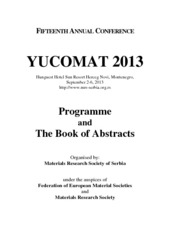Приказ основних података о документу
Routes and pathways to small particles based on hydroxyapatite
| dc.contributor | Uskoković, Dragan | |
| dc.creator | Ignjatović, Nenad L. | |
| dc.creator | Vranješ-Đurić, Sanja | |
| dc.creator | Mitić, Žarko | |
| dc.creator | Janković, Drina | |
| dc.creator | Uskoković, Dragan | |
| dc.date.accessioned | 2018-03-06T09:06:20Z | |
| dc.date.available | 2018-03-06T09:06:20Z | |
| dc.date.issued | 2013 | |
| dc.identifier.uri | http://dais.sanu.ac.rs/123456789/393 | |
| dc.identifier.uri | https://vinar.vin.bg.ac.rs/handle/123456789/7415 | |
| dc.description.abstract | Nanoparticles based on hydroxyapatite (NPs) have many useful physicochemical and biologicalproperties, such as easy preparation and modification, as well as biocompatibility, which make them suitable for transport and unloading of various pharmaceuticals. Hydroxyapatitenanoparticles coated with bioresorbable polymers have been successfully used as carriers ofantibiotics and vitamins in bone tissue engineering. In this study, we have investigated the synthesis of nanoparticles of hydroxyapatite and hydroxyapatite coated with chitosan and the chitosan-poly-D,L-lactide-co-glycolide polymer blend. The influence of the processing technique on the structure and characteristics of the obtained particles was studied by X-ray diffraction (XRD), particle size distribution analysis (PSD), Fourier transform infrared spectroscopy (FTIR), zeta potential analysis (ZP) and scanning electronic microscopy (SEM). In applied research, an appropriate radioisotope (Iodine-125) was selected and it was used to label particles. The in vivo biodistribution of 125I-labeled particles were studied in healthy Wistar rats following intravenous administration. The XRD, FT-IR and ZP analyses have confirmed that the hydroxyapatite particles with d50=72 nm are coated with chitosan and the chitosan-poly-D,L-lactide-co-glycolide polymer blend. 125I-labeled particles showed completely different behaviour in vivo: hydroxyapatite particles have the highest liver accumulation 10 min after injection but rapid excretion from the body without residual radioactivity 24 hours after injection; chitozan coated hydroxyapatite particles have the highest accumulation in the liver 10 min after injection with considerable amount (almost 50 %) retained 24 hours later; hydroxyapatite particles coated with the chitosanpoly-D,L-lactide-co-glycolide polymer blend have the highest uptake in the lungs 10 minutes after injection and moderate retention in the same organ 24 hours later. | en |
| dc.format | (2013) 7-7 | |
| dc.format | application/pdf | |
| dc.language | en | |
| dc.publisher | Belgrade : Materials Research Society of Serbia | |
| dc.relation | info:eu-repo/grantAgreement/MESTD/Integrated and Interdisciplinary Research (IIR or III)/45004/RS// | |
| dc.rights | openAccess | |
| dc.rights.uri | https://creativecommons.org/licenses/by-nc-nd/4.0/ | |
| dc.source | The Fifteenth Annual Conference YUCOMAT 2013: Programme and the Book of Abstracts | en |
| dc.subject | hydorxyapatite | |
| dc.subject | particles | |
| dc.subject | chitosan | |
| dc.subject | chitosan-poly-D,L-lactide-co-glycolide | |
| dc.title | Routes and pathways to small particles based on hydroxyapatite | en |
| dc.type | conferenceObject | |
| dc.rights.license | BY-NC-ND | |
| dcterms.abstract | Игњатовић, Ненад; Ускоковић, Драган; Врањеш Ђурић, Сања; Митић, Жарко; Јанковић, Дрина; | |
| dc.citation.spage | 7 | |
| dc.citation.epage | 7 | |
| dc.identifier.fulltext | https://vinar.vin.bg.ac.rs//bitstream/id/14020/7409.pdf | |
| dc.identifier.rcub | https://hdl.handle.net/21.15107/rcub_vinar_7415 |

